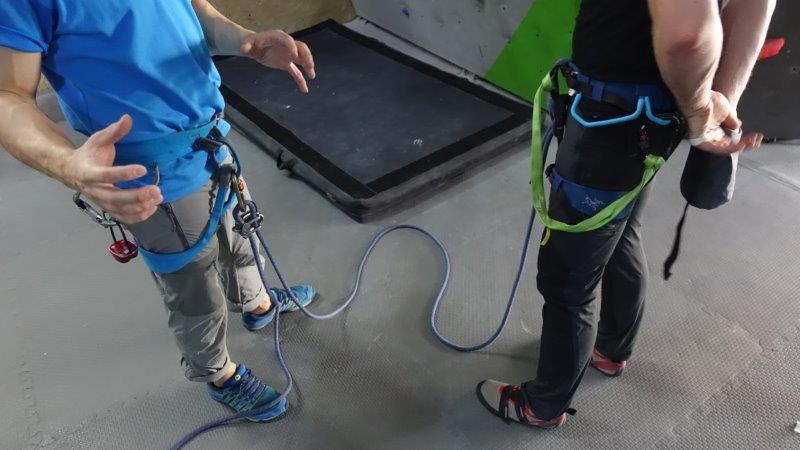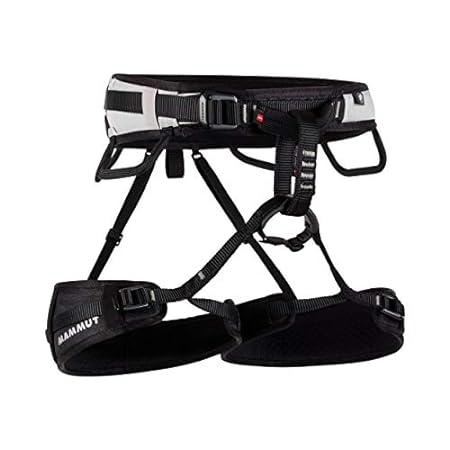Your climbing harness is arguably the most important piece of gear you bring with you on a climbing expedition. The attachments on your harness dictate your safety as you climb as well as your comfort as you explore the world above. Whether you’re a seasoned alpinist, or just starting out top-roping in the gym – it’s worth investing in a reliable and high-quality rock-climbing harness to keep you secure on the rope while ascending the rocks. Here are some of our top picks for best climbing harnesses based on personal experiences and fellow climber reviews.

What is the Best Climbing Harness?
Below you’ll find the list of the top 5 Best Climbing Harness. We compiled this list from climbing harnesses we have used, asked others about, and researched further to give you the best possible roundup. With many years of experience with climber harnesses you can be assured that this article will give you what you’re looking for.
We also wrote a buying guide and answered some of the frequently asked questions (FAQs) at the end of this article.
1. Mammut Men Ophir 3 Slide individuell
| Specs |
|---|
| Price: 💲 (fewer 💲 = cheaper) Weight: 1.81 pounds (0.82 kg) Number of Gear Loops: 4 Adjustable leg loops: Yes |
The Mammut Ophir is another example of an all-around capable harness from a reputable name in the climbing community. While a little bulkier than other efforts, the modestly priced and lightweight harness provides everything you need from a harness for a long multi-pitch or trad climbing route. There is adequete space to store all of your gear, it is fully adjustable through three traditional buckles, and the breathable material helps to reduce sweat buildup for those long exposed granite slabs.
Pros
- Surprisingly breathable for a harness.
- Fully adjustable legs.
- Four wide gear loops.
- Synthetic abrasion protection on the tie-in loop
Cons
- Monochromatic design makes it hard to distinguish features easily. Relatively bulky in comparison to other products on this list
2. PETZL – CORAX, Versatile and Adjustable Harness
| Specs |
|---|
| Price: 💲 (fewer 💲 = cheaper) Weight: 1.1 pounds (0.5 kg) Number of Gear Loops: 4 Adjustable leg loops: Yes User Weight Capacity: 264 lbs |
The Petzl CORAX is a highly versatile and affordable harness that’s best suited to single pitch crag days or gym climbing. Thanks to the double buckled waist belt, it’s highly adjustable so could easily be worn over your winter layers. However, with its bulkier build and missing ice clipper slots, it wouldn’t be our pick for a big mountain multi-pitch or alpine style day. On top of this, it’s not the most comfortable harness to hang about in.
Pros
- Double buckled waist loop and highly adjustable leg loops,
- Affordable,
- Lots of gear storage potential
Cons
- Quite a bulky harness,
- Ice clipper slots are missing,
- Not as comfortable to sit/hang in for long periods
3. Edelrid TreeRex Triple Lock Harness
| Specs |
|---|
| Price: 💲💲💲💲 (fewer 💲 = cheaper) Weight: 4.7 pounds (2.13 kg) Number of Gear Loops: 4 Adjustable leg loops: Yes User Weight Capacity: 330 lbs |
Edelrid is a trusted name in the rock climbing community and is known to make high quality climbing harnesses. The patented triple lock technology makes the Treerex harness one of the most versatile harnesses for tree care.
The 3D vent technology and semi-rigid padding makes it suitable for long periods of hanging in comfort.
4 big gear loops offer numerous attachment choices for gear and chainsaws. This harness comes assembled with a fully adjustable rope bridge and an aluminium connecting ring. The load-bearing straps have an indicator tape that turns red when worn out or damaged, sending a clear signal to the climber that the harness needs to be replaced.
Pros
- Patented triple lock buckles
- Breathable
- Leg loops have abrasion protectors made of dyneema
Cons
- Premium pricing
- Limited sizes available
4. Metolius Safe Tech Deluxe SB Harness
| Specs |
|---|
| Price: 💲💲💲 (fewer 💲 = cheaper) Weight: 2.47 pounds (1.12 kg) Number of Gear Loops: 4 Adjustable leg loops: Yes User Weight Capacity: 310 lbs |
The deluxe SB model is designed to maximize safety and also mobility on the routes tackling sit ins and wide moves. It provides sturdy support for the climber to excel on the sport climbing route with ease.
Pros
- Fully adjustable wait and leg loops
- Wide and well cushioned leg loops for optimal comfort
- Designed to provide lower back support
Cons
- Complex Double central loop,
- Gear loops are not symmetrical
5. KAILAS Airo Lightweight Climbing Harness
| Specs |
|---|
| Price: 💲 (fewer 💲 = cheaper) Weight: 0.86 pounds (0.39 kg) Number of Gear Loops: 3 Adjustable leg loops: Yes User Weight Capacity: 250 lbs |
A budget option from a lesser-known brand, Kailas, this harness boasts to be for more than just rock climbing. While it is UIAA certified, we are still inclined to trust this a little less, simply because it’s not from one of the rock-climbing brands we’ve had lots of experience with. Nonetheless, this is a comfortable and lightweight harness with lots of functionality for outdoor use (lots of gear storage potential and a rear haul loop). Kailas may well be onto something!
Pros
- A budget option,
- Super lightweight,
- Comfortable,
- Multifunctional
Cons
- Kailas is a less established brand in the harness manufacturing scene
Verdict
Based on all of our experience with climber harnesses, we found that Mammut Men Ophir 3 Slide individuell is the best climbing harness available today.
Our Premium Option is Edelrid TreeRex Triple Lock Harness with all the best features and high-quality materials, but that’s only if you have more money to spend.
However, if you are on a slightly tighter budget, you can also consider the KAILAS Airo Lightweight Climbing Harness as an affordable alternative.
Our other reviews you may find useful in your research:
What You Should Know Before Buying climbing harnesses
Key Features of Your Climbing Harness
It’s important for your safety and enjoyment on the climb by being familiar with your harness and understand its key features. No worries, though! Most rock climbing harnesses share a standard design, making them user-friendly.
Typically, a harness includes an adjustable waist belt and two leg loops connected by an elasticated cord. A thick cord known as the belay loop connects the waist and leg loops at the front. The top and bottom of the belay loop have smaller loops, called tie-in points. The tie-in points and the belay loop are the strongest parts of the harness and are designed to withstand force, connecting you securely to the climbing system.
Harnesses do vary, with some being lightweight and others focusing more on comfort and support, especially useful for long days in the mountains, such as in multi pitch climbing. Most will have gear loops for carrying your quickdraws, trad rack, or belay device, but the number and size of these will depend on the intended use of the harness.
Caring For Your Harness
Just like all the other gear that keeps you safe while climbing, it’s super important to take good care of your climbing harness. No matter what brand of harness you have, there are a few golden rules to follow: always store it in a dry place, keep it out of direct sunlight, and away from any chemicals like bleach. If it gets in contact with seawater, a gentle rinse without any cleaning agents will do. And, please, never make any modifications to your harness!
When you buy one, the sellers are required by law to give you instructions—usually on a tag—on how to clean and store it. You can also find this information on the supplier’s website.
Questions and Answers About climbing harnesses
How do I wear and use a climbing harness?
Climbing harnesses should be snugly fitted around the waist and above the hips. The leg loops tend to be left slightly looser around the thighs for more mobilty and comfort. Make sure the gear loops point downwards and the leg loops are the right way around, as it is a safety feature. If in doubt – ask another climber for assistance.
When tying in, the rope should be fed through both the attachment points and the belay device should be attached to the belay loop. Remember – the belay loops and tie in points tend to be the only parts of the harness that are rated to withstand force – so make sure you’re tying in and belaying from the right points! Again, a buddy-check with your climbing partner before you set off should be a regular part of your routine.
When should I replace my climbing harness?
A well cared-for harness that is always stored dry and isn’t exposed to damaging agents can last years (up to seven years is a general rule). Most would advise that you start carefully assessing your harness after three years of use. Any loose threads, fraying or tears are a clear sign that your harness is no longer safe to use. The belay loop being fuzzy is also a sign that you should be buying a new harness ASAP. Contact with any corrosive agents (e.g. bleach) constitutes an instant retiral. Bear in mind that continued exposure to saltwater will shorten the lifespan as well.
Which is the best climbing harness for big guys?
There are several options out there for climbing harnesses for big guys. Harnesses are fully adjustable, and often come in only one or two sizes but with multiple adjustment points to ensure that they fit bodies both large and small. The PETZL Sama is a great example of a fully adjustable harness that fits larger people, although all of the harnesses mentioned in this article are adjustable for multiple body sizes.



No Comments